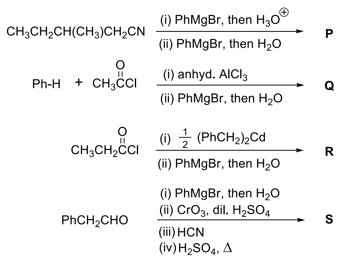"Girdling Experiment" was performed by Plant Physiologists to identify the plant tissue through which:
Important Questions on Plant Water Relation
In the following passage there are blanks, each of which has been numbered. There are questions given below the passage and for each question, four words are suggested, one of which fits the blank appropriately. Find out the appropriate word in each case.
Whenever I go into a bank, I feel scared. Everybody and everything that I see there (1) ____ me. As for the manager the sight (2) ____ him simply terrifies me and (3) ____ me want to runaway (4) _____ I can. As soon as I (5) ____ the door of the bank I lose my head (6) ____ when I try to do any (7) ____ there, I behave like an idiot. I cannot explain (8) ____ for this but that is how it (9) ____ has been that is how it is (10) ____.
Select the most appropriate option for blank No. 10.
Find correct statements from the following
Protein transporters are responsible for maximum rates of transport under saturated state
Translocation of substances in bulk flow requires hydrostatic pressure gradient
Root pressure plays the greatest contribution for upward movement of water in tall plants
Transport proteins of endodermal cells are control points for active transport of ions in two directions
The correct answer is
In the following reactions, P, Q, R and S are the major products.

The correct statement(s) about P, Q, R and S is(are)
Incoming sugars are actively transported out and removed as complex carbohydrates.
Increase of water potential.
Increase of hydrostatic pressure in sieve tubes.
Transport of water into sieve tubes by osmosis.
Consider the following reaction scheme and choose the correct option(s) for the major products Q, R and S.

The combination of numbered terms that correctly completes all the following statements is
i. Transport through the phloem is __1__ while transport through the xylem is __2__.
ii. Loading of sugars into the phloem is __3__ at the source.
iii. Movement of water out of the phloem at the sink is __4__.
A) Loading of sugars into phloem setup a water potential gradient that facilitates mass movement in phloem.
B) Sucrose moves into companion cell and then to phloem sieve tube cell by active transport.
C) A hypertonic condition in phloem facilitating water from the xylem into phloem by osmosis.
D) All sink sugars are transported out of the phloem producing high water potential with returning of water to xylem.
E) With increase in hydrostatic pressure in phloem pressure flow begin and sap moves through phloem.
Considering the reaction sequence given below, the correct statement(s) is(are)

In "Pressure Flow" hypothesis, sugars are transported from 'source' to 'sink'. The initial steps which occur during this physiological process are shown here.
I. In leaves glucose is converted to sucrose.
II. Sucrose moves from sieve tube cells to companion cells by active transport.
III. Loading of sucrose produces a hypotonic condition in the phloem.
IV. Water in the adjacent xylem moves into phloem by osmosis.
Identify the above correct statements:

